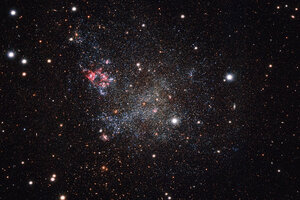Why scientists are calling this dwarf galaxy a 'clean freak'
Like other neighboring galaxies, the small dwarf galaxy of IC 1613 contains stars and planets. But unlike its neighbors, IC 1613 is dust-free.

This image, captured with the OmegaCAM camera on ESO’s VLT Survey Telescope in Chile, shows an unusually clear small galaxy. IC 1613 contains very little cosmic dust, allowing astronomers to more accurately gauge the brightness of its stars and its distance from Earth.
Courtesy of ESO
The Milky Way has a clean freak, next-door neighbor, says the European Southern Observatory (ESO).
Like other neighboring galaxies, the small dwarf galaxy of IC 1613 contains stars and planets. But unlike its neighbors, IC 1613 is dust-free – and that allows astronomers to see the galaxy’s sporadic pink gas and bright stars with impressive detail.
“However, what IC 1613 lacks in form, it makes up for in tidiness,” ESO says in a press release. “We know IC 1613’s distance to a remarkably high precision, partly due to the unusually low levels of dust lying both within the galaxy and along the line of sight from the Milky Way – something that enables much clearer observations.”
The lack of dust means better conditions for brightness evaluations, make it possible for scientists to calculate IC 1613's distance from Earth more accurately.
“As we know from our daily lives on Earth, shining objects such as light bulbs or candle flames appear dimmer the further they are away from us,” ESO explains. “Astronomers can use this simple piece of logic to figure out exactly how far away things are in the Universe – so long as they know how bright they really are, referred to as their intrinsic brightness.”
Astronomers are confident about IC 1613’s intrinsic brightness because of two types of stars that live in the galaxy: Cepheid variables and RR Lyrae variables. Both of these kinds of stars periodically pulse, allowing astronomers to measure the galaxy’s intrinsic brightness by measuring how quickly they see the stars’ bigger and brighter intervals.
“Stars of known intrinsic brightness can act like standard candles, as astronomers say, much like how a candle with a specific brightness would act as a good gauge of distance intervals based on the observed brightness of its flame’s flicker,” says ESO.
By measuring the pulsing stars, astronomers were able to pinpoint IC 1613's location at 2.3 million light-years away from Earth.
German astronomer Max Wolf discovered IC 1613 in 1906. The small galaxy was later confirmed as a member of the Local Group, a collection of over 50 galaxies including Earth’s home galaxy, the Milky Way.
While it may be a small galaxy, IC 1613 has served as a baseline for astronomers studying the universe’s expansion.
The latest up-close image was captured by the OmegaCAM camera on ESO’s VLT Survey Telescope at Paranal Observatory in Chile.

